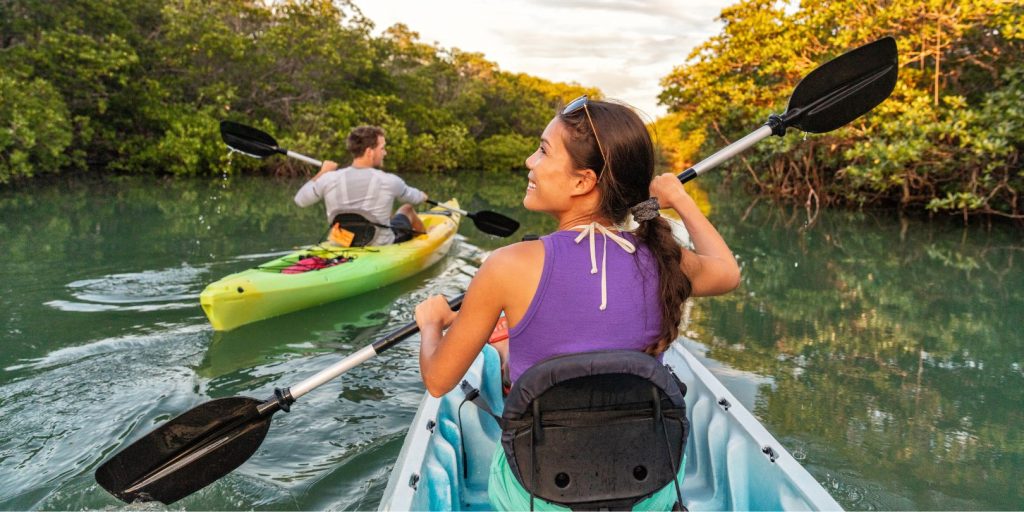River Kayaking: Safety Tips and How To Choose the Right Path

Immersing yourself in the gentle river flow, surrounded by nature’s serenity, is a captivating river kayaking experience. Whether you’re a novice or a seasoned paddler, the allure of navigating pristine waters is irresistible. However, beneath the surface of this exhilarating activity lies the importance of safety and informed decision-making.
This guide delves into the essential safety measures required for a secure river kayaking expedition. Moreover, we unravel the art of selecting the perfect course, considering factors like skill level, river dynamics, and environmental appreciation. Embark on this journey to discover how to paddle your way to an unforgettable and risk-mitigated adventure.
Safety First
Before setting off on your river kayaking adventure, address practicalities enhancing safety. One crucial aspect is acquiring a kayak roof rack for your vehicle, ensuring easy and secure transportation. This accessory not only prevents accidents on the road but also keeps your kayak intact, minimizing the risk of damage during transit.
Always wear a properly fitted personal flotation device (PFD) or life jacket. This is non-negotiable, regardless of your swimming abilities. A helmet is a good idea, especially if paddling through rapids or rocky areas.
Before embarking on your kayaking journey, check the weather forecast and water conditions. Avoid kayaking during storms, high winds, or rapidly changing water levels, as these factors can greatly increase the risk of accidents.
Familiarize yourself with fundamental paddling techniques before hitting the water. Knowing how to steer, balance, and control your kayak will help you navigate safely, even in challenging conditions.
Select a kayak that suits your skill level and the type of water you’ll be navigating. Whitewater kayaks are designed for fast-moving rivers with rapids, while recreational kayaks are better suited for calm waters.
Bring enough water to stay hydrated during your trip, and don’t forget to apply sunscreen to protect your skin from prolonged sun exposure. The combination of physical activity and sun can lead to dehydration and sunburn.
Before setting off, inform a friend or family member about your kayaking plans, including your intended route and estimated return time. This precaution ensures that someone knows your whereabouts in case of an emergency.
Choosing the Right Path:
Navigating various rivers requires an understanding of their distinct challenges. Begin by honestly assessing your kayaking proficiency. Novices should opt for rivers with tranquil waters and minimal obstacles, whereas intermediate and advanced paddlers can tackle more demanding courses.
Thorough research is paramount in selecting the right river for your kayaking expedition. Evaluate the river’s class (ranging from I to VI) to gauge its difficulty level. For valuable guidance, gain insights from online forums, guidebooks, and local paddling clubs.
The speed of water flow and the intensity of rapids significantly influence your kayaking journey. Seasoned kayakers thrive in swifter currents and higher rapids, while newcomers find solace in gentler waters.
Factor in the allure of the river’s surroundings and its wildlife. Some kayakers seek serene landscapes with awe-inspiring vistas, while others crave the excitement of maneuvering through rugged terrains.
Prioritize identifying accessible entry and exit points along the route, especially for extended trips. Chart your course strategically, allowing flexibility to disembark when necessary.
Certain rivers may mandate permits or enforce specific regulations to safeguard the ecosystem and kayakers’ safety. Always honor these guidelines and secure essential permits before embarking on your adventure.
For those unfamiliar with the locale or new to kayaking, consider enrolling in guided tours or consulting with local paddling experts. Their expertise will provide invaluable insights, ensure your safety, and elevate your overall experience.
Conclusion
River kayaking offers a thrilling way to engage with nature, but safety should always be your top priority. By wearing appropriate safety gear, understanding your skill level, researching rivers, and considering factors like water flow and accessibility, you can make informed decisions that lead to a safe and enjoyable kayaking adventure. Remember, the right path aligns with your abilities, preferences, and respect for the natural environment. So, paddle on and make unforgettable memories while keeping safety at the forefront.
